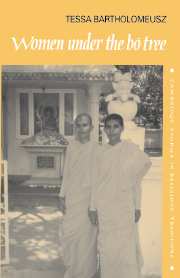Book contents
- Frontmatter
- Contents
- Preface
- Acknowledgments
- Notes on pronunciation
- Dramatis personae
- PART I
- PART II
- 5 The institutionalization of tradition: the early twentieth century and the lay nun
- 6 The lay nun in transitional Ceylon
- 7 The dasa sil mātā in contemporary Sri Lanka
- 8 Novitiates, western lay nuns, and cave dwellers
- 9 The Sri Lankan Bhikkhuī Saňgha: trends and reflections
- Epilogue: Women under the Bō tree
- Appendices
- Notes
- Select bibliographies
- Index and glossary
7 - The dasa sil mātā in contemporary Sri Lanka
Published online by Cambridge University Press: 05 November 2011
- Frontmatter
- Contents
- Preface
- Acknowledgments
- Notes on pronunciation
- Dramatis personae
- PART I
- PART II
- 5 The institutionalization of tradition: the early twentieth century and the lay nun
- 6 The lay nun in transitional Ceylon
- 7 The dasa sil mātā in contemporary Sri Lanka
- 8 Novitiates, western lay nuns, and cave dwellers
- 9 The Sri Lankan Bhikkhuī Saňgha: trends and reflections
- Epilogue: Women under the Bō tree
- Appendices
- Notes
- Select bibliographies
- Index and glossary
Summary
INTRODUCTION
In this chapter, I explore the contemporary practice of female renunciation in Sri Lanka. Though the laity continue to support female renunciants as many have done since the 1890s, a vast majority of lay nuns at present are impoverished; they find it difficult to ensure the laity's patronage. Moreover, women are no longer encouraged to renounce as they had been in the past; instead, they are expected to fulfill the role society has determined for them as wife and mother.
For many Buddhists in Sri Lanka, the conflict between social and religious obligations is a recurring phenomenon. For women, the conflict is usually resolved by giving priority to social demands, and conforming to female stereotypes. This is certainly the case with the contemporary lay nuns: the dasa sil mālāvo. That lay nuns never lose their association with their lay role as nurturers is perhaps best illustrated in a typical obituary of a lay nun:
Embuldeniya – Nanso Hamine Upāsikā Mathawa [sic], beloved wife of late Mr. D. S. Embuldeniya, loving mother of late Grace, Charlotte, Piyadassi Dayasena, Karunalatha, late Ghandradasa, expired…
It is striking that no mention is made of Embuldeniya Sil Mātā's lay nunnery connections, such as her teacher, and students. In other words, she is first and foremost a wife and mother, despite her renunciation of lay life. By comparison, the death announcement of a monk connects him to his monastery rather than to his blood relatives:
Ven. Dedigama Sri Saranankara Maha Thera – (Chief Incumbent of Sri Jayawardhanarama Purana Raja Maha Viharaya, Renagala, Nungamuwa, Yatigaloluwa and Sri Pujjyawardhanaramaya, Rangellepola). […]
- Type
- Chapter
- Information
- Women under the Bo TreeBuddhist nuns in Sri Lanka, pp. 130 - 155Publisher: Cambridge University PressPrint publication year: 1994

